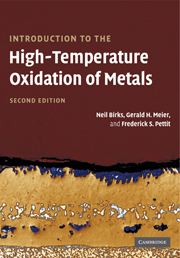Book contents
- Frontmatter
- Contents
- Acknowledgements
- Preface
- Introduction
- 1 Methods of investigation
- 2 Thermodynamic fundamentals
- 3 Mechanisms of oxidation
- 4 Oxidation of pure metals
- 5 Oxidation of alloys
- 6 Oxidation in oxidants other than oxygen
- 7 Reactions of metals in mixed environments
- 8 Hot corrosion
- 9 Erosion–corrosion of metals in oxidizing atmospheres
- 10 Protective coatings
- 11 Atmosphere control for the protection of metals during production processes
- Appendix A Solution to Fick's second law for a semi-infinite solid
- Appendix B Rigorous derivation of the kinetics of internal oxidation
- Appendix C Effects of impurities on oxide defect structures
- Index
- References
2 - Thermodynamic fundamentals
Published online by Cambridge University Press: 05 June 2012
- Frontmatter
- Contents
- Acknowledgements
- Preface
- Introduction
- 1 Methods of investigation
- 2 Thermodynamic fundamentals
- 3 Mechanisms of oxidation
- 4 Oxidation of pure metals
- 5 Oxidation of alloys
- 6 Oxidation in oxidants other than oxygen
- 7 Reactions of metals in mixed environments
- 8 Hot corrosion
- 9 Erosion–corrosion of metals in oxidizing atmospheres
- 10 Protective coatings
- 11 Atmosphere control for the protection of metals during production processes
- Appendix A Solution to Fick's second law for a semi-infinite solid
- Appendix B Rigorous derivation of the kinetics of internal oxidation
- Appendix C Effects of impurities on oxide defect structures
- Index
- References
Summary
Introduction
A sound understanding of high-temperature corrosion reactions requires the determination of whether or not a given component in a metal or alloy can react with a given component from the gas phase or another condensed phase, and to rationalize observed products of the reactions. In practice, the corrosion problems to be solved are often complex, involving the reaction of multicomponent alloys with gases containing two or more reactive components. The situation is often complicated by the presence of liquid or solid deposits, which form either by condensation from the vapour or impaction of particulate matter. An important tool in the analysis of such problems is, of course, equilibrium thermodynamics which, although not predictive, allows one to ascertain which reaction products are possible, whether or not significant evaporation or condensation of a given species is possible, the conditions under which a given reaction product can react with a condensed deposit, etc. The complexity of the corrosion phenomena usually dictates that the thermodynamic analysis be represented in graphical form.
The purpose of this chapter is to review the thermodynamic concepts pertinent to gas–metal reactions and then to describe the construction of the thermodynamic diagrams most often used in corrosion research, and to present illustrative examples of their application. The types of diagrams discussed are
Gibbs free energy versus composition diagrams and activity versus composition diagrams, which are used for describing the thermodynamics of solutions.
Standard free energy of formation versus temperature diagrams which allow the thermodynamic data for a given class of compounds, oxides, sulphides, carbides, etc., to be presented in a compact form.
[…]
- Type
- Chapter
- Information
- Introduction to the High Temperature Oxidation of Metals , pp. 16 - 38Publisher: Cambridge University PressPrint publication year: 2006
References
- 1
- Cited by



